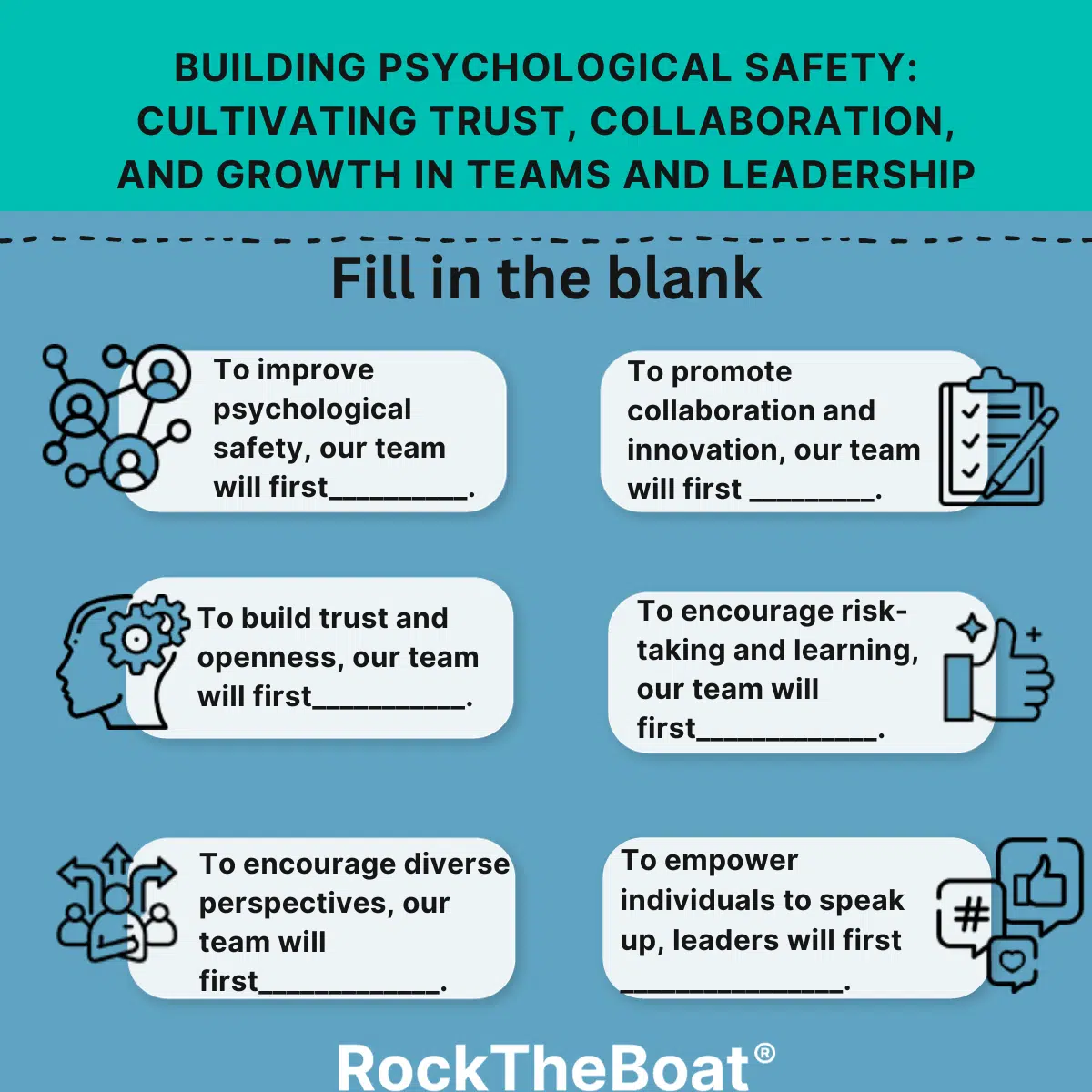To Improve Psychological Safety, Our Team Will First ________________.
Organizations that don’t foster psychological safety and belonging on teams can limit their potential for success and stifle performance. In this blog, we will explore the consequences of an absence of fostering psychological safety and belonging in teams. Based upon Amy Edmondson’s work on psychological safety and belonging on teams, you will learn simple how-to tips to create or restore safety and rituals that can help foster an environment where trust, collaboration, and growth can become realities. Plus, work collaboratively to fill in the blanks below to a series of questions like this: To Improve Psychological Safety, Our Team Will First ________________.
The absence of fostering psychological safety and belonging on teams:
- Leads to a suppressive interpersonal climate that disempowers employees from speaking up about problems or taking interpersonal risks.
- Prevents honest reporting of mistakes, errors, and failures.
- Employees typically experience a fear of backlash, negative consequences, or worse, being fired due to a blame culture or intolerance of mistakes and failure.
- When there is no sense of safety, it discourages people from taking risks, speaking up, and sharing ideas.
- This negatively impacts employee morale, well-being, and team performance, resulting in disengagement, apathy, low standards, missed opportunities, and lower productivity.
- Employee turnover increases, disrupting the team and becoming costly for hiring, onboarding, and training new employees.
Teams that possess psychological safety outperform teams without psychological safety.
Suppose you aim to thrive and succeed in a turbulent, uncertain, novel, and ambiguous world and are a team leader. In that case, there are several things you can do to foster psychological safety and belonging on your team.
Building Psychological Safety: Cultivating Trust, Collaboration, and Growth in Teams and Leadership
Collaborate to craft a sentence aligning with your team’s goals.
To improve psychological safety, our team will first ________________.
To build trust and openness, our team will first ________________.
To encourage diverse perspectives, our team will first ________________.
To promote collaboration and innovation, our team will first ________________.
To create a supportive and inclusive culture, our team will first ________________.
To address conflict constructively, our team will first ________________.
To encourage risk-taking and learning, our team will first ________________.
To foster psychological safety, leaders will first ________________.
To empower individuals to speak up, leaders will first ________________.
To promote a culture of feedback, leaders will first ________________.
Tips to Create or Restore Psychological Safety On Your Team:
- Frame the work, invite participation, and model the way.
- Model openness, curiosity, humility, vulnerability, and willingness to acknowledge mistakes.
- Create an interpersonal climate of safety to enable taking risks, speaking, and sharing ideas.
- Value and invite diverse perspectives.
- Promote a learning culture that embraces a growth mindset. Frame challenges as opportunities to learn and grow. Embrace opportunities to develop new skills. Be persistent and put in the effort required for mastery. Learn from feedback, and be open to constructive feedback and criticism.
- Reward risk-taking: reward it when someone raises concerns, flags errors, and catches and corrects mistakes.
- Embrace a praiseworthy and blameless interpersonal climate.
- Implement a blameless reporting system using the traffic light: Red: Off Track, Yellow: Possible Issue/Caution, Green: All Clear.
- Reflect on Team Dynamics: evaluate how the team works collaboratively and adjust as needed to improve team dynamics. Designate and rotate team members to lead meetings.
- Distinguish Task vs. Relationship Conflict. Task conflict entails debating the facts and logic, whereas relationship conflict entails unproductive personal accounts and emotional confrontations.
- Conflict Resolution: This requires managing self, conversations, and relationships.
- Promote, invite, and give growth-orientated feedback.
Rituals That Foster Psychological Safety Include:
Building a Strong Team: Enhancing Collaboration and Culture: These offerings enhance teamwork and foster a positive work environment.
- Think Tanks generate innovative ideas.
- Culture Hackathons promote inclusivity.
- Conversational Turn-Taking improves communication.
- Conflict Training resolves disputes constructively.
- Pre-Meeting Mantras set a positive tone.
- Kindness/Empathy Workshops cultivate compassion.
Ready to Foster Psychological Safety in Your Team?
If you’re ready to take proactive steps toward fostering psychological safety in your team, consider our Psychological Safety Team Coaching program. Our experienced coaches can help you create an environment where open communication, trust, and innovation thrive. Don’t let the silent threat of absent psychological safety hold your team back.
Recommended Reading
Meet Jodie, your Culture & Transformation Captain. With over twenty years helping people change, facilitating team discussions, building cultures, designing, implementing and teaching classes, your organization is in good hands.




